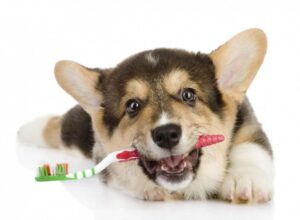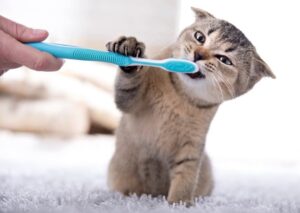 As humans we learn at an early age to brush our teeth. Do you as a pet owner brush your pets’ teeth? Periodontal disease or “gum disease” is the most common dental condition in dogs and cats. By the time your pet is 3 years old, he or she will very likely have some early evidence of periodontal disease. As you can imagine, as the years go on periodontal disease will worsen unless effective preventive measures are taken. Detecting this early will help your pet in the long run because periodontal disease doesn’t just affect your pet’s mouth. Kidney, liver, and heart muscle changes are found in association with periodontal disease. Cavities are less common in pets than in people, however they can have many other similar dental problems that people can develop such as broken teeth, abscesses, cysts/tumors and more.
As humans we learn at an early age to brush our teeth. Do you as a pet owner brush your pets’ teeth? Periodontal disease or “gum disease” is the most common dental condition in dogs and cats. By the time your pet is 3 years old, he or she will very likely have some early evidence of periodontal disease. As you can imagine, as the years go on periodontal disease will worsen unless effective preventive measures are taken. Detecting this early will help your pet in the long run because periodontal disease doesn’t just affect your pet’s mouth. Kidney, liver, and heart muscle changes are found in association with periodontal disease. Cavities are less common in pets than in people, however they can have many other similar dental problems that people can develop such as broken teeth, abscesses, cysts/tumors and more.
How can you tell if your pet may be having a problem? Look for the following signs in your pet:
• Bad breath
• Broken or loose teeth
• Teeth that are discolored or covered in tartar
• Retained baby teeth
• Abnormal chewing, drooling, or dropping food from the mouth
• Reduced appetite or refusal to eat
• Bleeding from the mouth
• Swelling in areas surrounding the mouth
The treatment of periodontal disease involves a thorough dental cleaning by a veterinary professional. Your veterinarian will make recommendations based on your pet’s overall health and the health of the teeth to provide you with options to consider.
 What can you do at home to help slow the progression of gum disease?
What can you do at home to help slow the progression of gum disease?
Well, the key to managing gum disease is prevention. If the surfaces of the teeth are cleaned frequently, the gums will stay healthy. Daily brushing like we do for ourselves is a gold standard. Pet safe toothpaste helps with this because they come in all sorts of “yummy” flavors your pet will love. However, not everyone can do this. Time and cooperation from our pet sometimes hinder our success! If brushing is not an option for you and your pet visit www.vohc.org/all_accepted_products.html. On this website you will find a list of accepted products to promote a healthy mouth which are broken down into categories such as diets, chews, treats, water additives, oral gels and more!
By Nicole Lecomte



